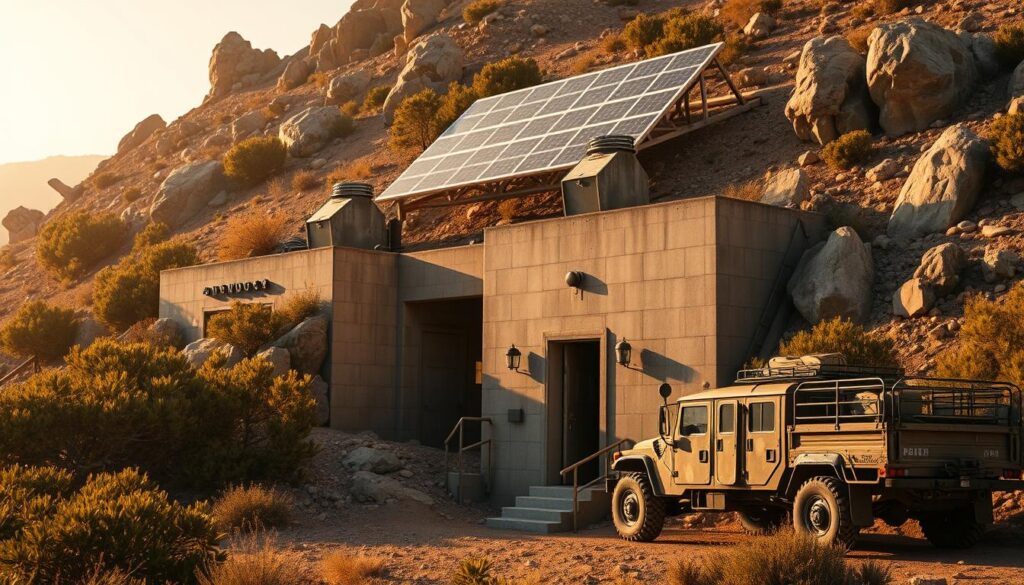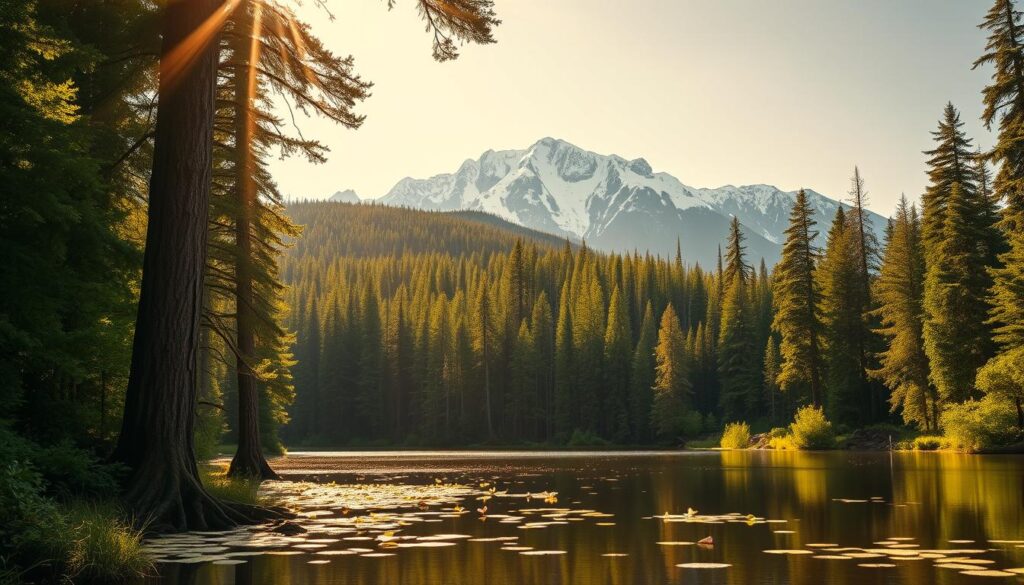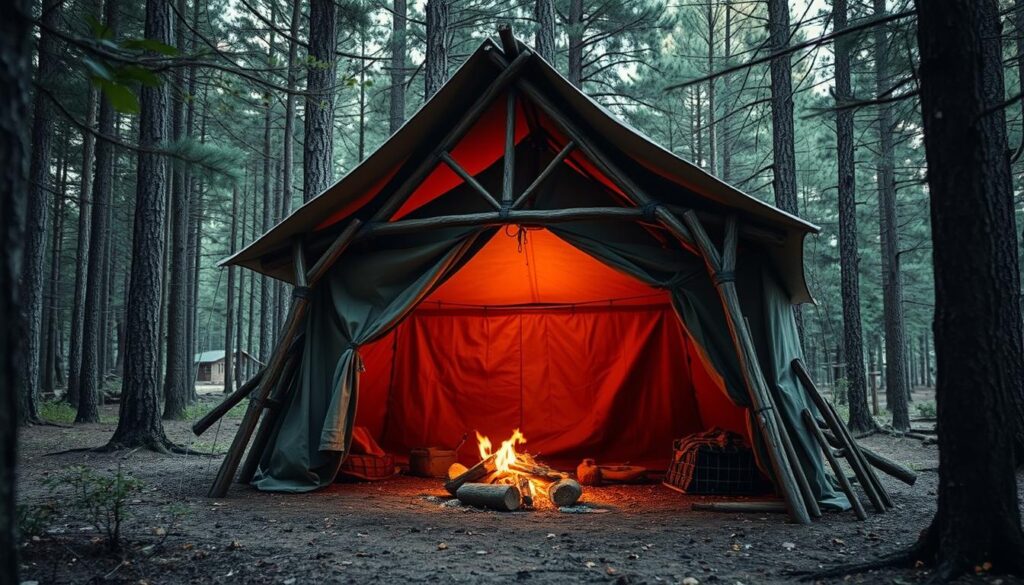Having a safe place during emergencies is key to survival. A good emergency shelter keeps you safe from the weather. It also stores important supplies and gives you peace of mind.
Creating a prepper shelter needs careful thought and planning. For more tips on building shelters, check out this site. It covers the basics of building shelters in the wilderness.
Key Takeaways
- A well-built shelter provides protection from natural elements.
- Careful planning is essential for building an effective shelter.
- A secure shelter can significantly enhance survival chances during emergencies.
- Understanding the basics of shelter building is important.
- A prepper shelter serves as a safe haven during crises.
Understanding the Importance of a Prepper Shelter
For those who value self-reliance, a prepper shelter is key. It’s not just a luxury; it’s a must-have for facing any emergency. This could be a natural disaster, economic collapse, or other crises.
What is a Prepper Shelter?
A prepper shelter is a safe spot in the wilderness or during emergencies. It can be a simple underground bunker or a more advanced off-grid shelter. Its main goal is to keep people safe, store supplies, and protect from harm.
Why Every Prepper Needs One
Every prepper needs a shelter as a safe place in crises. Here’s why:
- It protects from natural disasters like hurricanes, earthquakes, and floods.
- It’s a secure spot for vital supplies, like food, water, and medical gear.
- It offers a safe space to live in during long emergencies, giving a sense of security.
Key Reasons for Building a Shelter
Creating a bunker for preppers or any shelter needs careful planning. Key reasons include:
- To survive emergencies with a safe place to live.
- To protect oneself and loved ones from threats, natural or man-made.
- To have a sustainable living space with all needed supplies and resources.
Understanding the value of a prepper shelter and preparing one boosts safety and security in uncertain times.
Planning Your Shelter Location
Finding the perfect spot for a prepper shelter is key to its safety and success. The location must be chosen with care, considering several important factors.
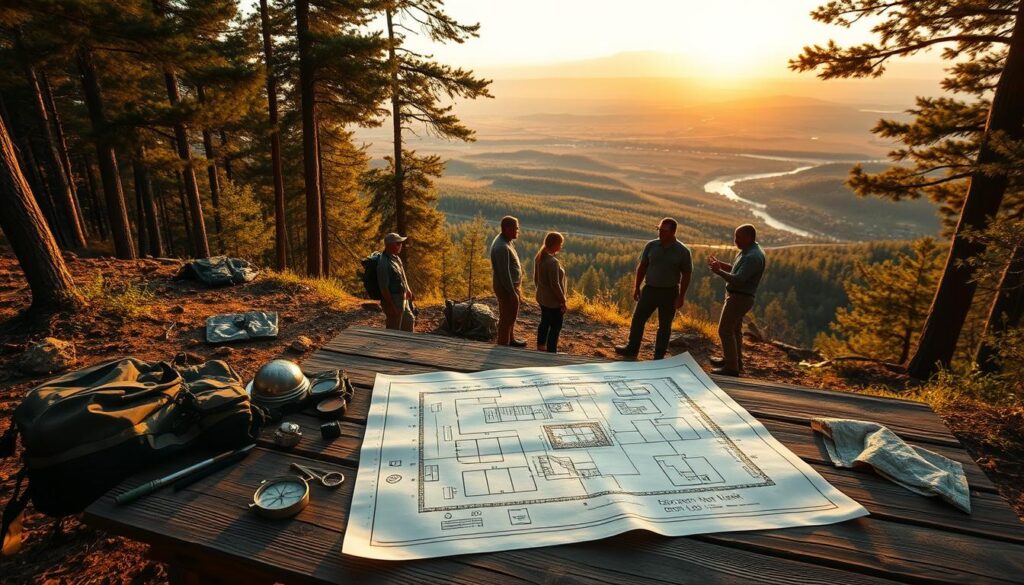
Evaluating Potencial Sites
When looking at sites for a prepper shelter, terrain and access are critical. The site should be flat and stable to make building easier and safer. Being close to roads and other infrastructure helps with getting supplies and moving people.
- Check if the terrain is stable and flat.
- Look at how close it is to roads and other important places.
- Think about how easy it is to get to in different weather.
Considering Natural Resources
The location of a prepper shelter should also think about natural resources. Having a steady water source, like a well or river, is essential. The site should also be good for growing food, either through gardens or animals.
Key natural resources to consider:
- Water sources (wells, rivers, rainwater collection).
- Land that can be used for gardens and growing food.
- Natural materials for building and making energy.
Safety From Natural Disasters
It’s also important to think about the site’s safety from natural disasters. Places that are often hit by earthquakes, floods, or hurricanes need special attention. A detailed risk assessment helps find and fix these problems.
Some key considerations include:
- Looking at earthquake risks and designing the shelter to handle them.
- Checking flood risks and making sure the shelter is safe from water.
- Thinking about hurricane risks and building the shelter to withstand strong winds.
By planning carefully and considering these points, people can make sure their prepper shelter is safe and ready for emergencies.
Choosing the Right Shelter Type
It’s important to know about the different prepper shelters. Your choice depends on what you like, how much you can spend, and the emergencies you’re preparing for.
Underground vs. Above Ground Shelters
Choosing between an underground or above-ground shelter is a big decision. Underground shelters, or survival bunkers, protect you from bad weather and radiation. They’re secure but can be hard and expensive to build.
On the other hand, above-ground shelters are easier and cheaper to make. But they might not be as safe as underground ones. Your choice depends on what you need and what you can afford.
Temporary vs. Permanent Structures
Think about if you need a temporary or permanent shelter. Temporary shelters are good for quick emergencies or when you might need to move. They’re cheaper and easy to set up.
Permanent shelters, like a doomsday shelter, are for long-term use. They cost more and take more planning but are safer and more stable for long emergencies.
Portable Shelters: Pros and Cons
Portable shelters are flexible and great for those who move a lot. They’re light and easy to put up, good for many situations. But they might not be as safe as fixed shelters.
When looking at portable shelters, think about the good and bad sides. They’re easy to move and use but might not be as strong or secure as a self-reliance shelter that’s fixed in place.
In summary, picking the right shelter means looking at several things. You need to think about how safe you want it to be, your budget, and what you like. Knowing about different shelters helps you choose the best one for you.
Essential Shelter Materials
Choosing the right materials is key for a long-lasting off-grid shelter. The materials you pick affect the shelter’s strength, safety, and how well it works. Each option has its own good and bad points.
Wood: Pros and Cons
Wood is a favorite for building shelters because it’s easy to find and use. It works well for frames, walls, and roofs. But, wood can rot, get damaged by insects, and catch fire. To avoid these problems, use treated wood or types that naturally resist rot.
Advantages: It’s easy to work with, affordable, and widely available.
Disadvantages: It can get damaged by insects, rot, and fire.
Using Concrete for Durability
Concrete is known for its strength and lasts a long time, making it great for a secure shelter. It protects well against disasters and threats. But, working with concrete needs special skills and tools.
Advantages: It’s very durable, strong against disasters, and secure.
Disadvantages: It needs special skills and tools, and can be expensive.
Alternative Materials to Consider
There are other materials for a prepper shelter too. Steel, earthbags, and recycled materials are options. Each has its own benefits and drawbacks.
| Material | Durability | Cost | Ease of Use |
|---|---|---|---|
| Wood | Moderate | Low to Moderate | Easy |
| Concrete | High | Moderate to High | Difficult |
| Steel | High | High | Moderate |
| Earthbags | High | Low | Moderate |
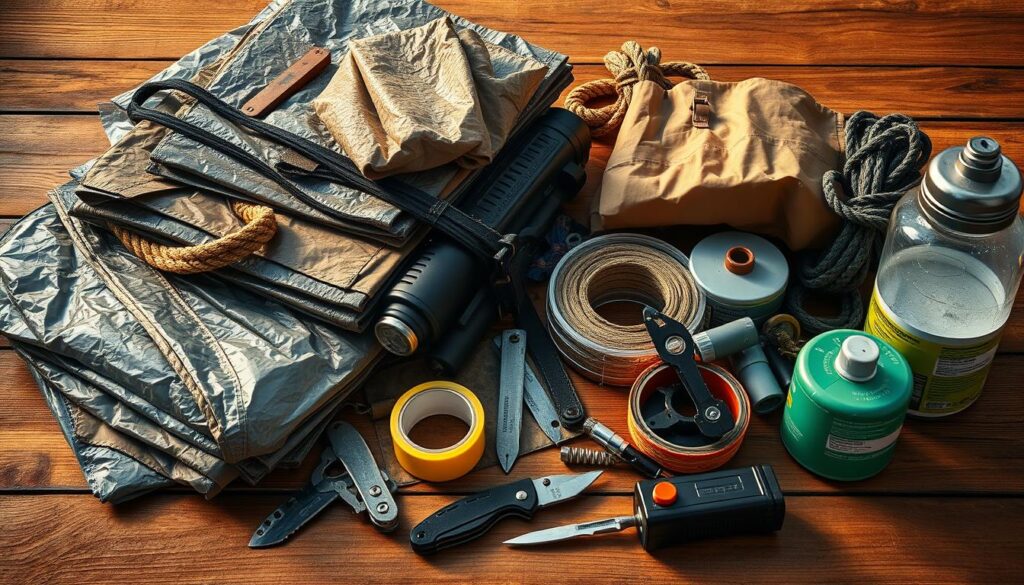
Designing Your Shelter Layout
A well-planned shelter layout is key for making the most of space. It ensures good air flow and easy access. These factors help create a space that’s both functional and comfortable.
Optimal Space Usage
In a survival bunker, space is precious. Use furniture and storage that does double duty. For example, bunks with storage underneath keep supplies handy and the floor clear.
Make the most of vertical space with shelves or storage units that reach the ceiling. This keeps the floor free and uses the shelter’s height effectively. Plan the layout to ensure easy movement, making the space comfortable to navigate.
Ventilation and Air Circulation
Good ventilation is essential in an emergency shelter. It removes stale air and prevents carbon dioxide buildup. A well-designed system includes intake and exhaust vents to keep air fresh.
Natural air flow can also be improved by the layout. For example, vents or windows on opposite sides create a cross breeze. This helps air circulate and reduces the need for mechanical systems.
Accessibility and Escape Routes
Accessibility and escape routes are vital in a self-reliance shelter. The layout should make all areas easy to reach, even in the dark. Use clear signs and keep paths open.
Having multiple escape routes is also important for safety. A good shelter allows quick and safe exit in emergencies. This might mean having more than one exit, with at least one hidden for added security.
Building a Prepper Shelter: DIY vs. Professional
Choosing between DIY and professional construction for a prepper shelter is a big decision. It depends on cost, project complexity, and your skills.
Advantages of DIY Construction
DIY construction can save money and let you customize your shelter. You can avoid high labor costs and make changes as you go. This way, you can tailor the shelter to fit your needs perfectly.
Key Benefits of DIY:
- Cost savings on labor
- Flexibility in design and construction
- Personal satisfaction of completing the project oneself
When to Hire a Professional
For complex projects, like an underground bunker, hiring a pro is wise. They bring the needed expertise and tools. This ensures your shelter is safe, meets codes, and lasts long.
Consider hiring a professional if:
- The project involves complex engineering or excavation
- Local regulations require professional oversight
- You lack experience in construction or related fields
Cost Considerations
The cost of a prepper shelter or bunker for preppers varies. It depends on materials, size, and whether you do it yourself or hire someone. A detailed cost analysis helps find the best option for your budget.
| Cost Factor | DIY Costs | Professional Costs |
|---|---|---|
| Materials | $5,000 – $10,000 | $10,000 – $20,000 |
| Labor | $0 (self labor) | $5,000 – $15,000 |
| Total | $5,000 – $10,000 | $15,000 – $35,000 |
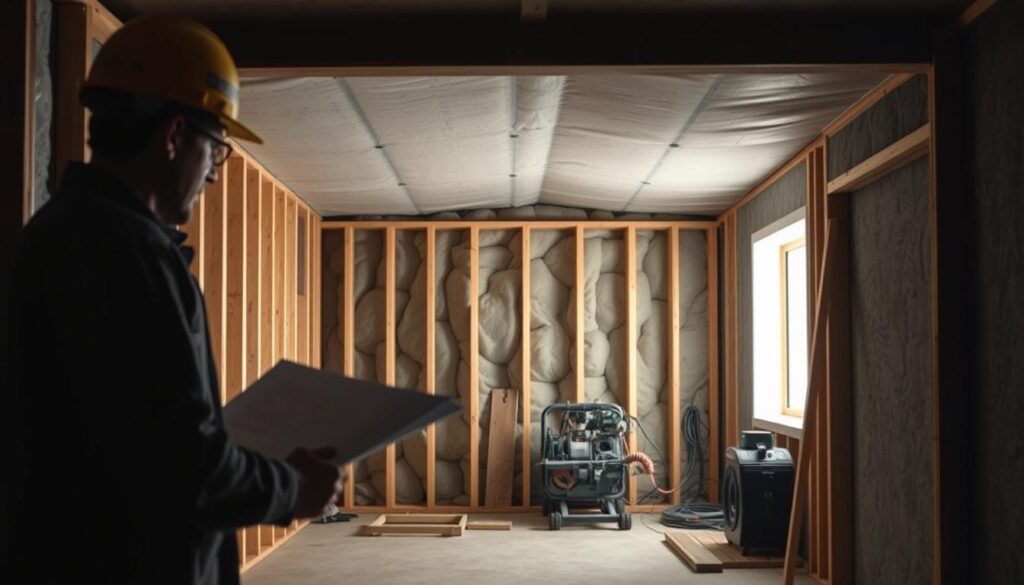
In conclusion, the choice between DIY and professional construction depends on your situation. Consider your budget, skills, and the project’s complexity. This way, you can make a choice that fits your needs best.
Essential Features for Survival
Building a prepper shelter means adding key features for survival. A good shelter can be the key to life in emergencies.
Key features include food storage, a water source, and energy and heating options. These are vital for keeping the shelter safe and habitable for a long time.
Food Storage Solutions
Food storage is key in a prepper shelter. It’s important to keep food safe and fresh. Non-perishable food items are best because they last a long time without refrigeration.
Effective ways to store food include:
- Mylar bags for long-term storage
- Sealed buckets to protect against moisture and pests
- Canned goods for extended shelf life
Survival expert
“A well-stocked food supply is the backbone of any survival plan. It’s not just about having food, but having the right kind of food that can sustain you over time.”
Water Source and Filtration
Clean water is vital for survival. A prepper shelter needs a reliable water source, like a well or rainwater collection. Also, a water filtration system is key to make sure the water is safe to drink.
| Water Source | Filtration Method | Effectiveness |
|---|---|---|
| Rainwater Collection | Ceramic Filters | High |
| Well Water | UV Purification | Very High |
| Gray Water | Mechanical Filtration | Moderate |
Energy and Heating Options
A prepper shelter needs a reliable energy source for lighting, heating, and powering important equipment. Solar power and generators are good choices for off-grid energy.
For heating, you can use:
- Propane heaters for efficient warmth
- Wood-burning stoves for sustainable heating
- Electric heaters for backup
With these essential features, a prepper shelter can be a safe and sustainable place during emergencies. It supports survival and can even be a long-term home.
Legal Considerations and Zoning Laws
Before you start building a prepper shelter, you need to understand zoning laws and regulations. It’s not just about building; it’s also about following the law. Laws vary a lot from place to place.
Researching Local Regulations
First, you must research local laws. You need to know the zoning laws, building codes, and permits needed in your area. Local government websites and planning departments are great places to start.
Some places have rules about the size and type of structures you can build. Others might not allow underground shelters. You also need to think about environmental laws that could affect your project.
Permits Needed for Construction
After you know the local laws, you need to get the right permits. The permits you need depend on your shelter’s location, size, and type. You might need building permits, electrical permits, and plumbing permits.
| Permit Type | Description | Typical Requirements |
|---|---|---|
| Building Permit | Required for the construction of the shelter structure. | Detailed construction plans, site map, and structural engineering plans. |
| Electrical Permit | Necessary for any electrical work within the shelter. | Electrical wiring diagrams, plans for electrical systems, and inspection reports. |
| Plumbing Permit | Required for installing water supply and sewage systems. | Plumbing system designs, material specifications, and inspection schedules. |
Understanding Property Rights
It’s important to know your property rights when building a prepper shelter. This means understanding what you can do on your land and any limits set by local laws or neighbors. Easements and restrictive covenants can also affect your rights.
An easement might let a utility company access your land for maintenance. A restrictive covenant could limit what you can build. Always check your property deed and talk to local authorities to understand your rights.
By researching local laws, getting the right permits, and knowing your property rights, you can build your prepper shelter legally. This helps avoid legal problems later on.
Enhancing Security in Your Shelter
Keeping your emergency shelter safe is key to protecting against dangers. A secure shelter not only keeps people safe but also protects the supplies and equipment inside.
Physical Security Measures
Physical security is the first defense for any survival bunker or prepper’s shelter. It uses strong materials and designs to resist forced entry or environmental dangers. Important features include reinforced doors, secure locks, and materials that can withstand blasts.
Key physical security measures include:
- Reinforced walls and ceilings
- Secure entry and exit points
- Anti-tunnel features to prevent unauthorized access
Surveillance and Detection Systems
Modern preppers can boost their shelter’s security with advanced surveillance and detection systems. These include CCTV cameras, motion detectors, and alarm systems that warn of threats. Adding these systems can greatly improve your shelter’s safety.
Consider the following when installing surveillance systems:
- Coverage of all entry points and vulnerable areas
- Night vision capability for 24/7 monitoring
- Integration with alarm systems for real-time alerts
Community Networking for Safety
While physical and tech security are important, community networking is also vital. Creating a network of trusted people and families offers extra support and resources in emergencies.
Benefits of community networking include:
| Benefit | Description |
|---|---|
| Shared Resources | Pooling resources can enhance the sustainability of your shelter |
| Mutual Support | Having a community provides emotional and physical support during crises |
| Enhanced Security | A community can offer additional security measures through collective vigilance |
Preparing for Long-Term Occupancy
Building a prepper shelter means planning for long-term use. It should be a safe place during emergencies. A well-prepared shelter supports your needs for a long time.
Stockpiling Essential Supplies
It’s important to stock up on non-perishable food, clean water, and medical supplies. Think about how many people will use the shelter. Your shelter should last for a long time.
Sustainable Living Plans
For sustainable living, use renewable energy like solar or wind power. Also, have a plan for food, like gardening or hydroponics. This keeps your shelter comfortable and habitable.
Regular Maintenance
Keeping your shelter in good shape is key. Check it often, fix any problems, and update your supplies. This keeps your off-grid shelter in top condition.
FAQ
What is a prepper shelter, and why do I need one?
A prepper shelter is a safe place to hide from dangers like natural disasters and societal problems. It’s essential for keeping you safe during emergencies.
What are the key factors to consider when choosing a location for my prepper shelter?
Look for a spot with natural resources, low risk of disasters, and is safe. Good planning makes your shelter effective.
What types of prepper shelters are available, and which one is right for me?
You can pick from underground bunkers, above-ground structures, or temporary shelters. The best choice depends on your needs, budget, and preferences.
What materials should I use to build my prepper shelter?
Use wood, concrete, and other materials based on your design, budget, and protection needs.
How do I design an effective shelter layout?
Plan for the best use of space, ventilation, and easy access. A good layout makes your shelter comfortable and useful.
Should I build my prepper shelter myself or hire a professional?
Decide based on your skills, project complexity, and budget. Think about DIY vs. hiring a pro before you choose.
What features are essential for survival in a prepper shelter?
Key features include food storage, water, and energy sources. These help you survive for a long time.
Are there any legal considerations I should be aware of when building a prepper shelter?
Yes, follow local laws, get permits, and know property rights. This avoids legal problems.
How can I enhance security in my prepper shelter?
Boost security with physical barriers, surveillance, and joining a safety network. These steps protect you and your shelter.
How do I prepare my prepper shelter for long-term occupancy?
Stock up on supplies, plan for sustainable living, and maintain your shelter. This keeps it safe and comfortable for a long time.
What is an off-grid shelter, and how does it differ from a traditional prepper shelter?
An off-grid shelter runs on its own without public utilities. It’s different from traditional shelters because it’s self-sufficient.
Can I build a doomsday shelter, and what are the key considerations?
Yes, building a doomsday shelter is possible. It needs careful planning, resources, and knowledge of essential components like radiation protection and air supply.
What is a self-reliance shelter, and how can it benefit me?
A self-reliance shelter helps you prepare for emergencies and live independently. It’s a safe place for you to be self-sufficient.
How can I ensure my prepper shelter remains safe and secure over time?
Keep up with maintenance, security updates, and training. Stay alert and adapt to changes to keep your shelter safe.

